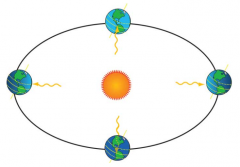![]()
![]()
![]()
Use LEFT and RIGHT arrow keys to navigate between flashcards;
Use UP and DOWN arrow keys to flip the card;
H to show hint;
A reads text to speech;
29 Cards in this Set
- Front
- Back
|
Earth– our biosphere |
§Thebiosphere refers to the thin layer of Earth that has conditions suitable for life,includes:§Allliving things§Thephysical environment that supports those living things |
|
|
Atmosphere |
§:Layer of gases that surround the Earth |
|
|
Lithosphereq2% |
a.k.a. Earth’s crust – the solid portion off the Earth (includes the land under the oceans)wQ |
|
|
Hydrosphereq2%+ |
§Allthe water on Earth (includes liquid, vapour and ice) |
|
|
Percentages: Atmosphere |
§78%N2(g)§21%O2(g)§1% other§“Other”includes Ar, CO2,Ne, He, CH4and Kr |
|
|
atmospheric dust |
§Includesliving things (e.g., pollen, micro-organisms) and non-living (e.g., soot) |
|
|
Troposphereq2%+ |
§From0 to 10 km§Temperature:15oCto -60oC §Onlylayer of the atmosphere with a mix of gases and temperature to support a variety of life (including humans) §Containsmost of the CO2and H2Oand atmospheric dust present in the atmosphere§Wheremost of our weather occurs, including wind and precipitationr |
|
|
Stratosphere |
From10 to 50 km§Temperature:-60oCto 0oC Onlyisolated clumps of living cells found living in this layer Containsmost of the ozonelayer§Ozoneis a molecule made up of three oxygen atoms (O3(g))§Protectsliving organisms from sun’s UV radiation |
|
|
Mesosphere |
From50 to 80 km§Temperature:0oCto -100oC |
|
|
Thermosphere |
From 80 to 300 km§Temperature: 100oC to 1500oC§Named for the high temperatures near the edge of thelayer (closest to the sun) |
|
|
Lithosphere |
§Floatson top of the fluid layer called the mantle§Extendsfrom the Earth’s surface inward§Asthin as 5 km and as thick as 100 km in places§Warmedboth by the heat from the sun and the heat from Earth’s core |
|
|
Hydrosphere |
§About97% is salt water in the oceans§Theother 3% is fresh water, but is mostly frozen in snow and glaciers |
|
|
Altitude |
¡Thedistance above Earth’s surface, measured from the upper surface of the oceans(sea level)false} |
|
|
Inversion |
Areversal of normal temperature patterns seen in the troposphere¡Maytrap unusually cold air close to the ground¡Tendsto occur in areas close to the mountains where the air is forced to travel upover the higher elevations |
|
|
WEATHER |
Day-to-dayconditions, including:§Temperatureand air pressure§Cloudcover and humidity§Precipitation |
|
|
CLIMATE |
Averageconditions occurring over a period of 30 years or longer§E.g.,Alberta has a relatively cold and dry climate compared to Brazil, which is warmand humid |
|
|
Climatechange |
§refersto a noticeable change in average temperatures in a region over time |
|
|
Indirectevidence |
§Treering analysis§Icecore sampling§Fossilrecord of insects§Pollensampling from the bottom of lakes¡ |
|
|
Treerings |
§reflectthe changing seasons of cold and drought, warmth and precipitation during thelife of a tree |
|
|
The Earth’s atmosphere consists of four layers. List the layers in order of increasing altitude: (closest to Earth à furthest from Earth) |
Troposphere, Stratosphere, Mesosphere, Thermosphere |
|
|
Albedo |
The percent of solar radiation that a surface reflects;Because snow and ice have a much higher albedo, regions that are frozen reflectmore light than regions without snow or ice (albedo in Edmonton is higher inthe winter than in the summer) |
|
|
Angleof inclination |
Due to the tilt of the Earth, areas further from theequator (like Edmonton) see more changes in seasonal temperatures and thenumber of daylight hours |
|
|
Angleof incidence |
Due to the spherical shape of the Earth, areas furtherfrom the equator (like Edmonton) get less direct and intense sun |
|
|
Insolation |
Amount of sunlight (solar energy) an area gets; the climate of a region is largely determined by the insolation the area gets |
|
|
a. wintersolstice (right)b. summersolstice (left)c. springequinox (top)d. fall equinox(bottom)e. the day withthe maximum number of daylight hours June21 (northern hemisphere)f. the day with the minimum number of daylighthours December 21 (northern hemisphere)g. the periodof time where the days get longer Wintersolstice to summer solsticeh. the periodof time where the days get shorter Summersolstice to winter solsticei. the twopoints in time where the daylight = nighttime hours Spring equinox, fall equinox |

|
|
|
Convection |
The transfer of thermal energy through the movement ofparticles from one location to another |
|
|
Tradewinds |
are the normal windpatterns that transfer heat around theglobe |
|
|
Jetstreams |
are bands of fast moving air in thestratosphere that travel much faster than wind in the troposphereChanges in normal jet stream patterns are important inpredicting weather changes and extreme weather events such as storms andcyclones |
|
|
theCoriolis effect. |
Convection currents causes air tomove directly North-South. However, since the Earth is spinning, the winds aredeflected to the right (in the Northern Hemisphere) or the left (in theSouthern Hemisphere). This deflection is called the Coriolis Effect. |

